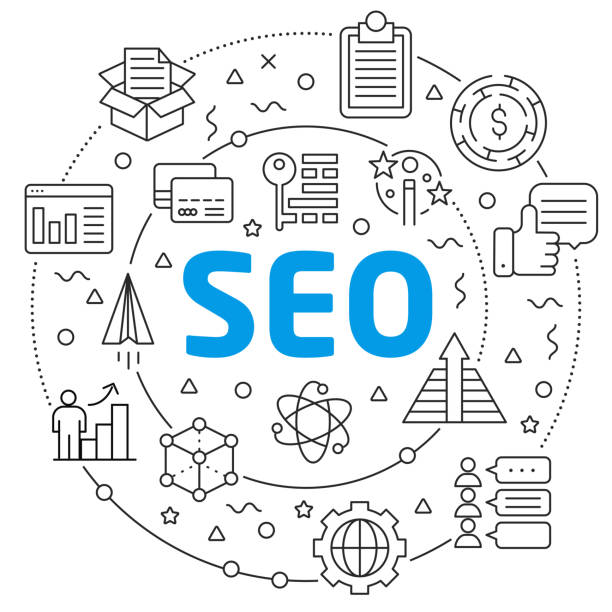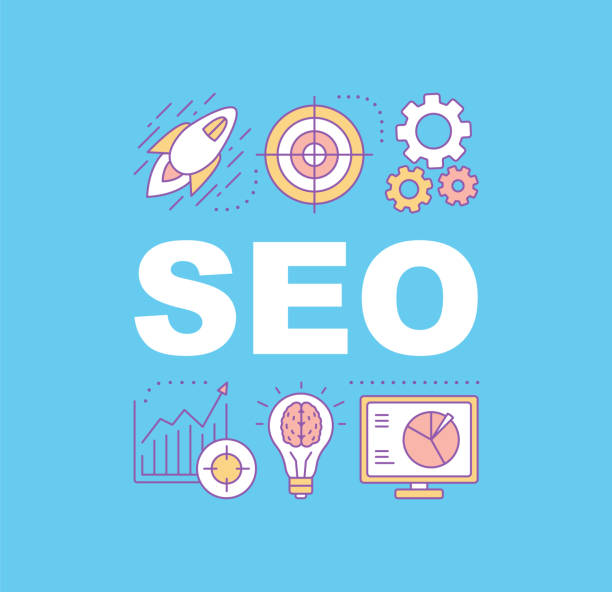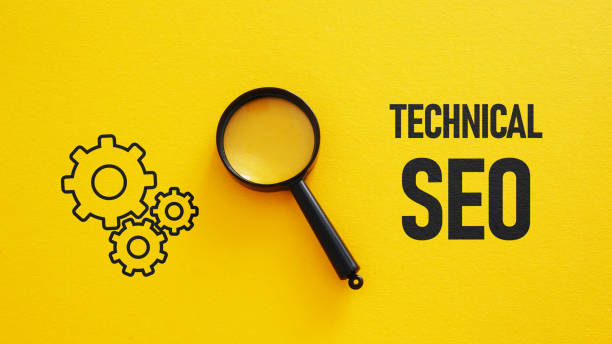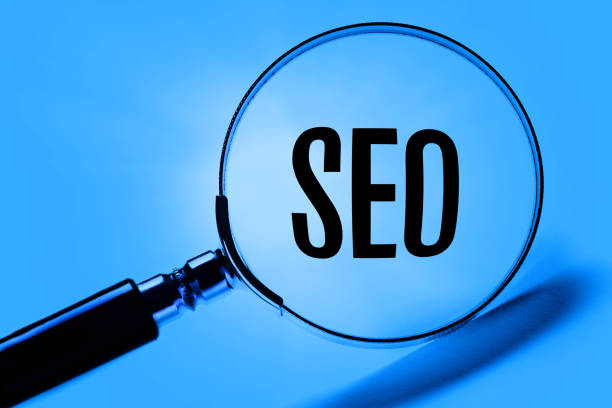Introduction to SEO and its Importance in the Present Era

In today’s highly competitive world, an online presence is not enough just by having a website.
To be seen and attract an audience, every business and individual needs a deep understanding of the importance of SEO.
#SEO, or Search Engine Optimization, is a set of processes and techniques that help your website achieve a higher ranking in the organic search results of engines like Google, Bing, and Yahoo.
This process #explains how search engines understand and rank your website.
The main goal of SEO is to increase #quality_traffic to your website, meaning to attract users who are genuinely interested in your products, services, or content.
Achieving top rankings not only enhances your brand’s credibility but also significantly increases visitors and ultimately improves conversion rates.
This is a long-term investment that ensures the sustainability and growth of your business in the digital space.
Does your current e-commerce website design not generate the expected sales for you?
RasaWeb specializes in professional e-commerce website design!
✅ An attractive and user-friendly website aimed at increasing sales
✅ High speed and security for an ideal shopping experience⚡ Get a free consultation for online store design with RasaWeb!
The Main Pillars of SEO: On-Page, Off-Page, and Technical

SEO is a broad concept with three main pillars: On-Page SEO, Off-Page SEO, and Technical SEO.
On-Page SEO refers to all actions you take within your website to improve its ranking.
This includes keyword optimization, Title Tags, Meta Descriptions, URL structure, content quality, and image optimization.
This part of SEO is crucial because it provides the foundation for search engines’ understanding of your content.
Off-Page SEO refers to activities performed outside your website aimed at increasing its credibility and Domain Authority.
The most important part of Off-Page SEO is Link Building, which means acquiring backlinks from other reputable websites.
These backlinks show search engines that your content is valuable and trustworthy.
Finally, Technical SEO focuses on your website’s technical infrastructure to ensure that search engines can easily crawl and index your site.
Site loading speed, mobile compatibility, site structure, and the use of Sitemaps and Robots.txt files are among the important aspects of Technical SEO.
All these aspects together contribute to improving your overall site SEO.
Keyword Research: The Cornerstone of Every SEO Strategy

Keyword research is the first and perhaps most important step in any SEO strategy.
This process involves identifying the words and phrases that your target users enter into search engines to find content, products, or services similar to yours.
Comprehensive keyword research not only helps you better understand your target audience but also provides deep insights into search volume, competition level, and user intent behind each keyword.
Keywords can be categorized into different types, each with its own significance.
Short-tail keywords generally have high search volume and intense competition, while Long-tail keywords have lower search volume but much more specific user intent and higher conversion rates.
This section provides practical guidance for finding the best keywords for your SEO strategy.
Using tools like Google Keyword Planner, Ahrefs, and Semrush can be very helpful in this process.
A proper understanding of these keywords allows you to produce content that exactly matches user needs and increases your chances of achieving top rankings in search results.
Here is a table for a better understanding of keyword types:
| Keyword Type | Number of Words | Search Volume | Competition Level | User Intent | Example |
|---|---|---|---|---|---|
| Short-tail | 1-2 words | High | Very High | General | “shoe” |
| Mid-tail | 2-3 words | Medium | Medium to High | Slightly more specific | “men’s sports shoes” |
| Long-tail | 4+ words | Low | Low | Very specific with purchase/information intent | “best men’s running shoes” |
Producing Quality and SEO-Driven Content

Content is king, and this statement becomes even more important in the world of SEO.
Producing quality, valuable, and engaging content is the core of a successful SEO strategy.
Search engines are increasingly focusing on the quality and relevance of content to user intent.
Your content should not only include target keywords but also answer users’ questions, provide accurate information, and engage them.
This can include blog articles, educational guides, infographics, videos, and podcasts.
Thought-provoking content that makes the user think and invites interaction can increase the Dwell Time on the site, which itself is a positive signal for search engines.
Another important aspect is content freshness; regularly updating old content and adding new content to the site demonstrates continuous activity and the provision of up-to-date information to users.
For SEO-driven content, you should also pay attention to its structure: use appropriate headings (H1, H2, H3), short paragraphs, lists, and incorporate images and videos to break up text and improve readability.
The ultimate goal is to provide content that is not only optimized for SEO but also offers an excellent user experience and provides real value to your audience.
Does your current website build the trust that potential customers should have in your business? If the answer is no, it’s time to have your professional and impactful corporate website with RasaWeb.
✅ Fully customized design tailored to your brand identity
✅ Increased lead generation and business credibility in the eyes of customers⚡ Contact us for a free consultation!
Technical SEO: Ensuring Site Health

Technical SEO often operates behind the scenes, but its role in a website’s success in search results is undeniable.
This part of SEO focuses on optimizing the technical aspects of your website to ensure that search engines can easily crawl, index, and understand your pages.
Page Speed is one of the most important ranking factors; a site that loads quickly provides a better user experience and has a lower Bounce Rate.
Mobile-friendliness is also of great importance, as most searches are currently performed via mobile devices, and Google prioritizes mobile-friendly websites.
Site Structure and Navigation should be logical and simple so that users and search bots can easily navigate the site.
Proper use of the Robots.txt file to control bot access to specific parts of the site and XML Sitemaps to inform search engines about all available pages are other key components of Technical SEO.
Fixing crawl errors, implementing SSL certificates for security (HTTPS), and optimizing Structured Data are also specialized actions that help improve search engines’ understanding of your content and contribute to strong SEO.
Quality Link Building and Its Strategies

Link Building is one of the most powerful pillars of Off-Page SEO and means acquiring backlinks (Hyperlinks) from other websites to your site.
These backlinks are considered “votes of confidence” from other sites to your content and show search engines that your website is credible, valuable, and relevant.
However, the important point is that the quality of links is more important than their quantity.
Backlinks from websites with high Domain Authority and relevance to your niche have significantly more value.
Various link-building strategies exist, including: creating valuable content that naturally attracts links, guest posting on relevant websites, building relationships with bloggers and influencers, and Broken Link Building.
Avoiding Black Hat SEO, which includes buying links or using link farms, is crucial, as these methods can lead to your site being penalized by search engines.
A correct guidance strategy in link building focuses on creating valuable content and promoting it so that others naturally link to it.
With a systematic and ethical approach, you can consistently increase your site’s domain authority and significantly improve your SEO results.
Data Analysis and SEO Performance Monitoring

After implementing SEO strategies, the next and very important step is performance analysis and continuous monitoring.
Without data, identifying strengths and weaknesses and continuous optimization will be impossible.
Tools such as Google Search Console and Google Analytics are vital resources for gathering information about your website’s performance in search results.
Google Search Console provides insights into how your site is crawled and indexed by Google, the keywords you rank for, and any potential errors.
Google Analytics provides detailed information about site traffic, user behavior (such as pages visited, time spent on site, bounce rate), and conversion rates.
This data allows you to see which SEO strategies have been effective and which need optimization.
Monitoring keyword rankings, reviewing organic traffic, and analyzing backlinks are among the routine activities at this stage.
This analytical approach not only helps you measure your current performance but also identifies opportunities for further improvement and adaptation to changes in search engine algorithms.
Here is a table of key SEO metrics for performance monitoring:
| Metric | Explanation | Monitoring Tool | Importance for SEO |
|---|---|---|---|
| Organic Traffic | Number of visitors from search engines | Google Analytics | Indicates overall strategy success |
| Keyword Rankings | Site position in results for target keywords | Google Search Console, Ahrefs, Semrush | Most direct indicator of keyword performance |
| Bounce Rate | Percentage of users who leave the site without interacting | Google Analytics | Indicates content quality and user experience |
| Dwell Time | Average time users spend on a page | Google Analytics | Indicates content engagement and relevance |
| Backlinks | Number and quality of inbound links to the site | Ahrefs, Semrush, Moz | Important factor in domain authority and ranking |
Latest Google Algorithms and Their Impact on SEO

The world of SEO is constantly evolving, and Google regularly updates its algorithms to provide users with more relevant and higher-quality search results.
Staying informed about these changes is essential for every SEO specialist.
Algorithms like Panda focused on content quality, Penguin on link quality, and Hummingbird on understanding the meaning behind searches.
In recent years, Google has placed significant emphasis on concepts such as Core Web Vitals (including loading speed, interactivity, and visual stability) and Page Experience.
Furthermore, AI-powered algorithms like RankBrain and BERT, and now MUM, have dramatically increased Google’s ability to understand natural language and provide more accurate results for complex queries.
This means that merely including keywords in the text is no longer sufficient; instead, content must be truly valuable, comprehensive, and relevant to user intent.
Google’s continuous updates highlight the need for a flexible approach to SEO.
Webmasters must always be ready to adapt their strategies to new changes to prevent drops in ranking and traffic.
This process requires a continuous educational approach.
Do your e-commerce site visitors leave before making a purchase? Don’t worry anymore! With RasaWeb’s professional e-commerce website design services, permanently solve the problem of not converting visitors into customers!
✅ Significant increase in conversion rates and sales
✅ Unique and engaging user experience
⚡ Contact us now for a free consultation!
Local SEO and Its Importance for Physical Businesses

While global SEO deals with national and international rankings, Local SEO focuses on optimizing businesses’ online presence for local searches.
This type of SEO is crucial for shops, restaurants, clinics, and any physical business looking to attract customers near its location.
When users search for “restaurants near me” or “best car repair shop in [city name],” local SEO results are displayed.
The three main factors in Local SEO, known as NAP, include your business’s Name, Address, and Phone Number.
This information must be consistent and accurate across all online platforms, especially Google My Business (GMB).
Optimizing your GMB profile, collecting positive customer reviews, and creating Local Citations from other websites are among the key strategies in Local SEO.
Additionally, using local keywords (such as “SEO in Tehran” or “Yazd coffee shop”) in website content and optimizing pages for specific geographical locations helps search engines connect your business to local searchers.
This is a specialized approach that helps small and medium-sized businesses increase their local market share and attract more customers through targeted SEO.
The Future of SEO: AI and User Experience

The future of SEO is more intertwined than ever with Artificial Intelligence (AI) and User Experience (UX).
Search engines, relying on more advanced AI algorithms, are gaining a deeper understanding of the meaning behind searches and users’ true needs.
This means that focusing solely on keywords and backlinks will no longer be sufficient; instead, content that truly addresses user needs, is well-organized, and provides an enjoyable user experience will be prioritized.
Voice and image search are also growing trends that impact how content is optimized for SEO.
Furthermore, the increased use of entertaining and interactive content such as videos, podcasts, and thought-provoking content indicates shifts in user preferences.
Future SEO specialists must not only be familiar with the technical principles of SEO but also possess a deep understanding of user psychology, UI/UX design, and creative content production.
Machine learning and natural language processing have elevated search engines’ understanding of content and its context to a new level.
These developments require a continuous educational approach and the ability to adapt to emerging technologies to lead in the digital competition.
Ultimately, SEO is moving towards providing real and distinct value to users, rather than merely tricking algorithms.
Frequently Asked Questions
| Question | Answer |
|---|---|
| What is SEO? | SEO, or Search Engine Optimization, is the process of increasing the quality and quantity of website traffic by improving the site’s ranking in organic search results of search engines like Google. |
| What are the main types of SEO? | SEO is divided into three main categories: On-Page SEO, Off-Page SEO, and Technical SEO. |
| What does On-Page SEO include? | On-Page SEO includes optimizing elements within the website, such as keywords, Title Tags, Meta Descriptions, content, URL structure, images, and internal links. |
| What is Off-Page SEO? | Off-Page SEO refers to activities outside the website that help improve its ranking, such as Backlink Building, social media marketing, and Brand Mentions. |
| What is Technical SEO? | Technical SEO focuses on optimizing the technical aspects of a website to help it be better crawled and indexed by search engines. This includes site speed, mobile-friendliness, site structure, Sitemaps, and Robots.txt files. |
| What role do Keywords play in SEO? | Keywords are phrases that users enter into search engines. Proper and targeted use of relevant keywords in content and site elements helps search engines understand your page’s topic and display it for relevant searches. |
| What is a Backlink and why is it important? | A backlink, or inbound link, is a link from one website to another. Backlinks act as a “vote of confidence” from other sites to search engines and play a significant role in a site’s credibility and ranking increase, especially if they come from reputable sites. |
| What impact does quality content have on SEO? | Quality, relevant, comprehensive, and unique content not only attracts and retains users but also shows search engines that your page is valuable. This helps improve rankings, reduce Bounce Rate, and increase user dwell time on the site. |
| Why is site loading speed important for SEO? | Site loading speed is an important ranking factor for Google. Faster sites provide a better user experience, have lower bounce rates, and are preferred by search engines. |
| Is SEO a one-time process? | No, SEO is an ongoing and long-term process. Search engine algorithms are constantly changing, competition is increasing, and site content also needs updating. Therefore, SEO requires continuous monitoring, analysis, and optimization. |
And other advertising services of RasaWeb Advertising Agency
Smart Custom Software: Transform customer behavior analysis with the help of marketing automation.
Smart Conversion Rate Optimization: A dedicated service for growth in customer acquisition based on user experience customization.
Smart UI/UX: A professional solution to increase click-through rates by focusing on SEO-driven content strategy.
Smart Website Development: An innovative service for increasing sales through marketing automation.
Smart Sales Automation: Transform digital branding with the help of attractive user interface design.
And over a hundred other services in the field of internet advertising, advertising consulting, and organizational solutions
Internet Advertising | Advertising Strategy | Advertorials
Sources
Complete SEO GuideComprehensive SEO ArticlesRankon SEO TrainingMozhan SEO and Digital Marketing
? Is your business ready to leap into the digital future? RasaWeb Afarin Digital Marketing Agency, by offering comprehensive services including website design with a modern user interface, SEO, and social media management, paves the way for your success. Contact us today and transform the future of your brand.
📍 Tehran, Mirdamad St., next to Central Bank, Kazeroon Janoubi Alley, Ramin Alley No. 6




